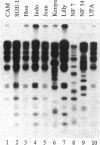Abstract
We argue that the mode of reproduction of microorganisms in nature can only be decided by population genetic information. The evidence available indicates that many parasitic protozoa and unicellular fungi have clonal rather than sexual population structures, which has major consequences for medical research and practice. Plasmodium falciparum, the agent of malaria, is a special case: the scarce evidence available is contradictory, some suggesting that uniparental lineages may exist in nature. This is puzzling (because P. falciparum is known to have a sexual stage) and poses a challenge that can be readily settled by ascertaining the frequency distribution of genotypes in natural populations.
Full text
PDF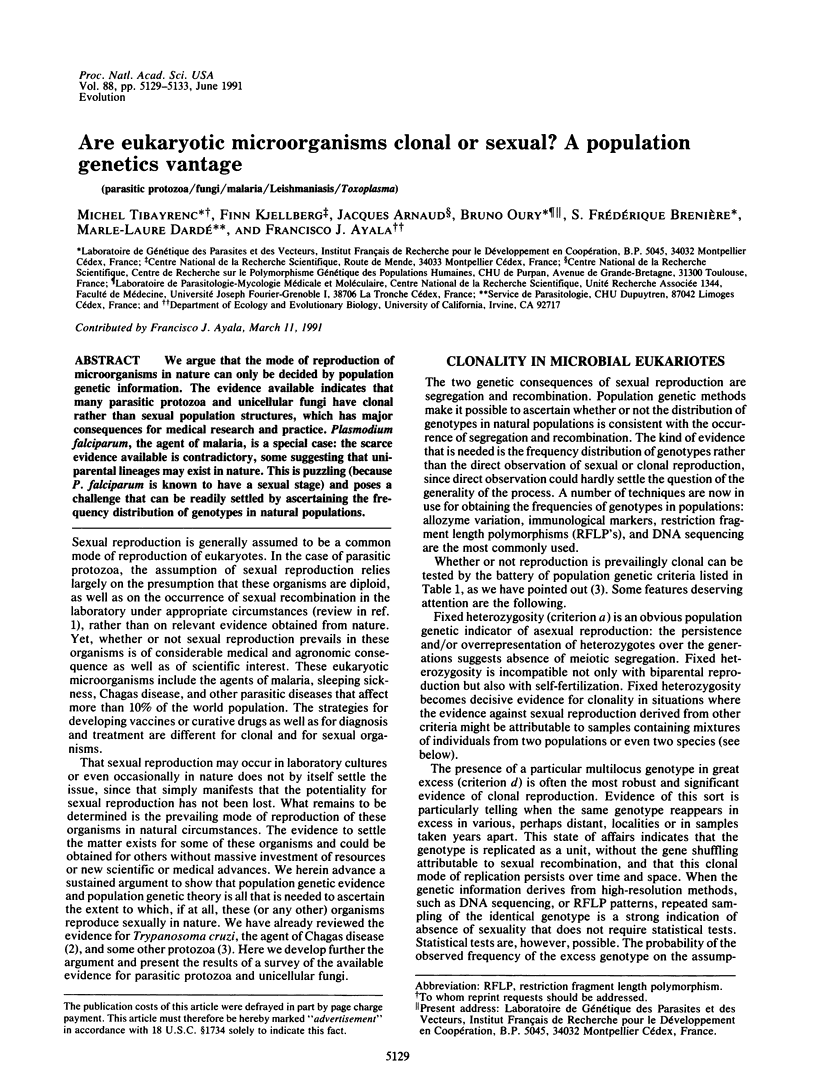
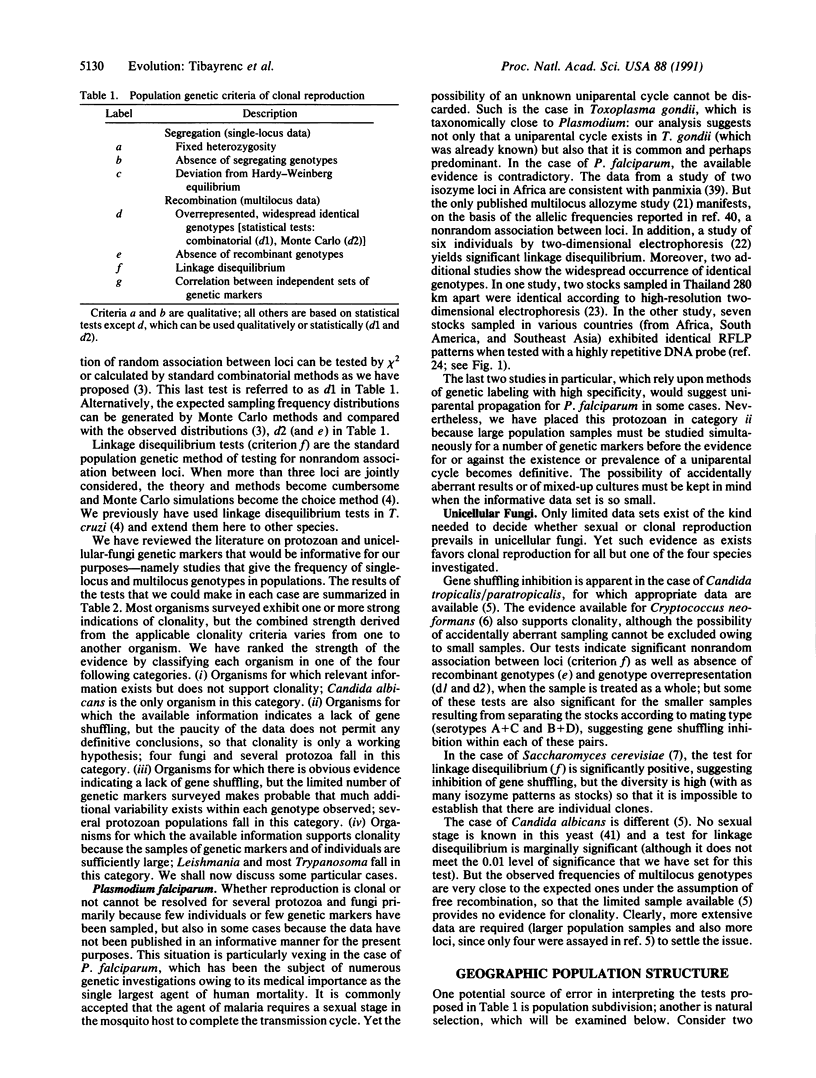
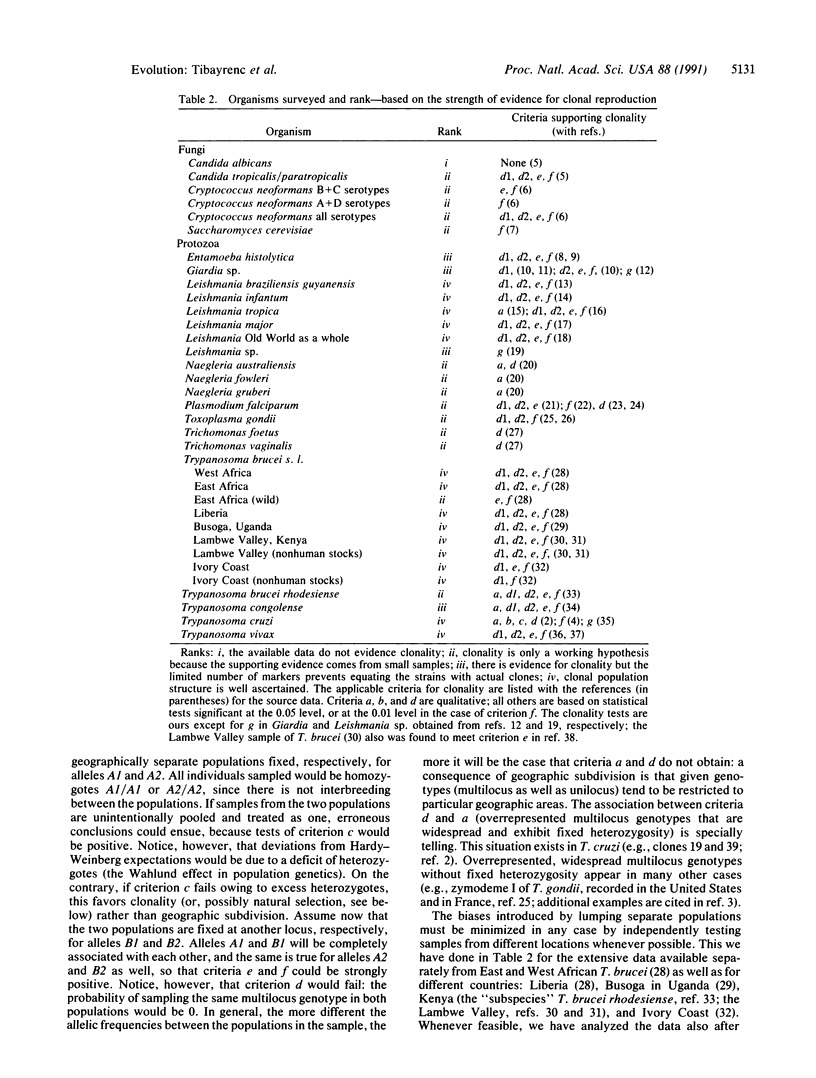
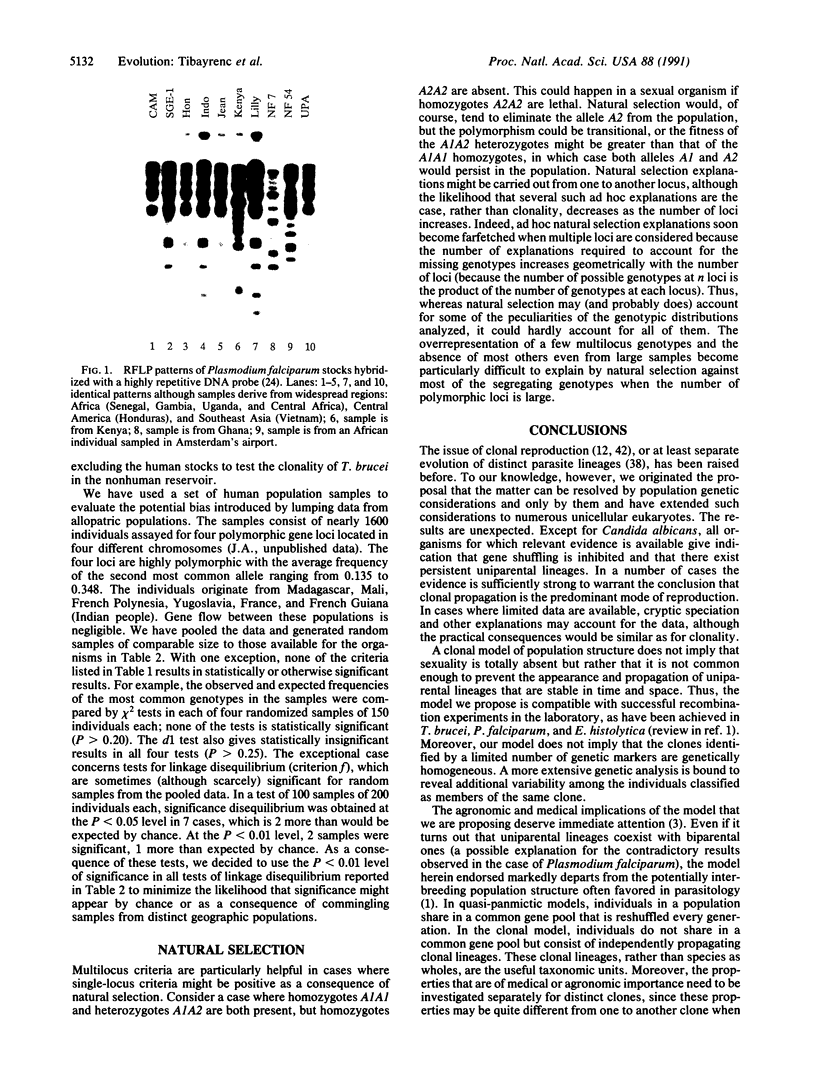
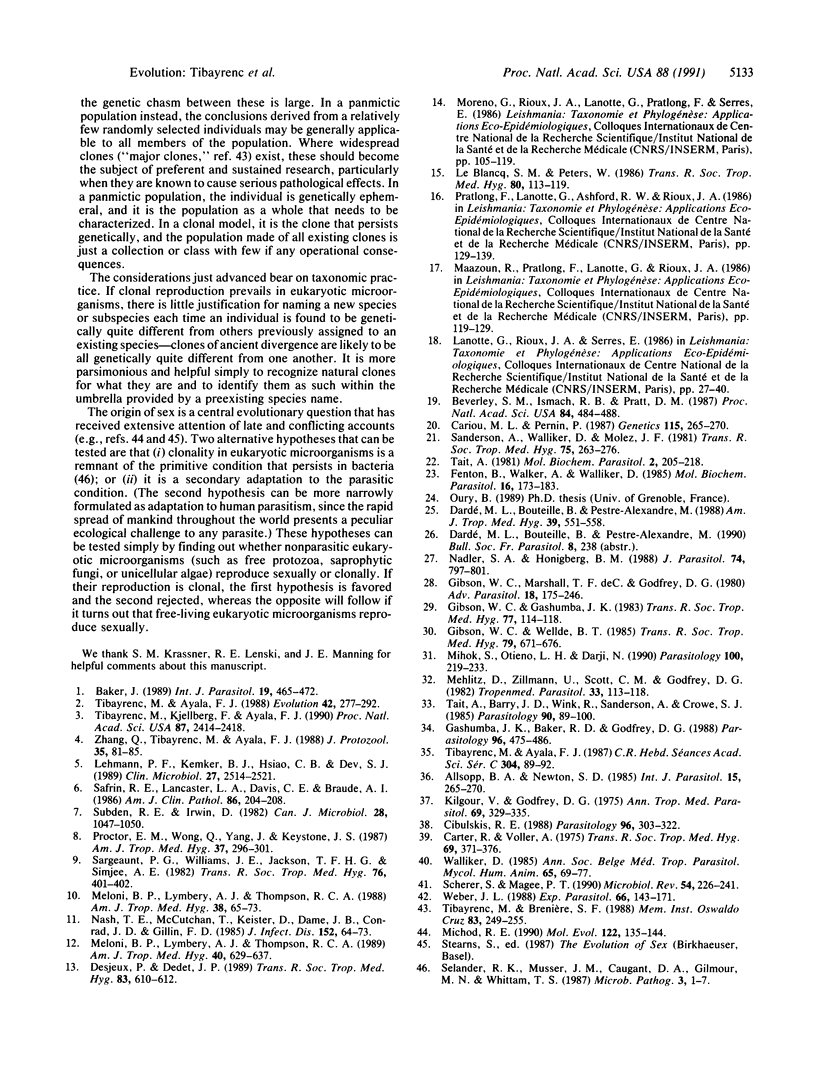
Images in this article
Selected References
These references are in PubMed. This may not be the complete list of references from this article.
- Allsopp B. A., Newton S. D. Characterization of Trypanosoma (Duttonella) vivax by isoenzyme analysis. Int J Parasitol. 1985 Jun;15(3):265–270. doi: 10.1016/0020-7519(85)90063-3. [DOI] [PubMed] [Google Scholar]
- Baker J. R. Sexual processes in parasitic protozoa. Int J Parasitol. 1989 Aug;19(5):465–472. doi: 10.1016/0020-7519(89)90075-1. [DOI] [PubMed] [Google Scholar]
- Beverley S. M., Ismach R. B., Pratt D. M. Evolution of the genus Leishmania as revealed by comparisons of nuclear DNA restriction fragment patterns. Proc Natl Acad Sci U S A. 1987 Jan;84(2):484–488. doi: 10.1073/pnas.84.2.484. [DOI] [PMC free article] [PubMed] [Google Scholar]
- Cariou M. L., Pernin P. First evidence for diploidy and genetic recombination in free-living amoebae of the genus naegleria on the basis of electrophoretic variation. Genetics. 1987 Feb;115(2):265–270. doi: 10.1093/genetics/115.2.265. [DOI] [PMC free article] [PubMed] [Google Scholar]
- Carter R., Voller A. The distribution of enzyme variation in populations of Plasmodium falciparum in Africa. Trans R Soc Trop Med Hyg. 1975;69(4):371–376. doi: 10.1016/0035-9203(75)90191-1. [DOI] [PubMed] [Google Scholar]
- Cibulskis R. E. Origins and organization of genetic diversity in natural populations of Trypanosoma brucei. Parasitology. 1988 Apr;96(Pt 2):303–322. doi: 10.1017/s0031182000058315. [DOI] [PubMed] [Google Scholar]
- Darde M. L., Bouteille B., Pestre-Alexandre M. Isoenzymic characterization of seven strains of Toxoplasma gondii by isoelectrofocusing in polyacrylamide gels. Am J Trop Med Hyg. 1988 Dec;39(6):551–558. doi: 10.4269/ajtmh.1988.39.551. [DOI] [PubMed] [Google Scholar]
- Desjeux P., Dedet J. P. Isoenzyme characterization of 112 Leishmania isolates from French Guiana. Trans R Soc Trop Med Hyg. 1989 Sep-Oct;83(5):610–612. doi: 10.1016/0035-9203(89)90373-8. [DOI] [PubMed] [Google Scholar]
- Fenton B., Walker A., Walliker D. Protein variation in clones of Plasmodium falciparum detected by two dimensional electrophoresis. Mol Biochem Parasitol. 1985 Aug;16(2):173–183. doi: 10.1016/0166-6851(85)90085-4. [DOI] [PubMed] [Google Scholar]
- Gashumba J. K., Baker R. D., Godfrey D. G. Trypanosoma congolense: the distribution of enzymic variants in east and west Africa. Parasitology. 1988 Jun;96(Pt 3):475–486. doi: 10.1017/s0031182000080112. [DOI] [PubMed] [Google Scholar]
- Gibson W. C., Gashumba J. K. Isoenzyme characterization of some Trypanozoon stocks from a recent trypanosomiasis epidemic in Uganda. Trans R Soc Trop Med Hyg. 1983;77(1):114–118. doi: 10.1016/0035-9203(83)90033-0. [DOI] [PubMed] [Google Scholar]
- Gibson W. C., Wellde B. T. Characterization of Trypanozoon stocks from the South Nyanza sleeping sickness focus in Western Kenya. Trans R Soc Trop Med Hyg. 1985;79(5):671–676. doi: 10.1016/0035-9203(85)90187-7. [DOI] [PubMed] [Google Scholar]
- Gibson W. C., de C Marshall T. F., Godfrey D. G. Numerical analysis of enzyme polymorphism: a new approach to the epidemiology and taxonomy of trypanosomes of the subgenus Trypanozoon. Adv Parasitol. 1980;18:175–246. doi: 10.1016/s0065-308x(08)60400-5. [DOI] [PubMed] [Google Scholar]
- Kilgour V., Godfrey D. G., Na'isa B. K. Isoenzymes of two aminotransferases among Trypanosoma vivax in Nigerian cattle. Ann Trop Med Parasitol. 1975 Sep;69(3):329–335. doi: 10.1080/00034983.1975.11687016. [DOI] [PubMed] [Google Scholar]
- Le Blancq S. M., Peters W. Leishmania in the Old World: 2. Heterogeneity among L. tropica zymodemes. Trans R Soc Trop Med Hyg. 1986;80(1):113–119. doi: 10.1016/0035-9203(86)90208-7. [DOI] [PubMed] [Google Scholar]
- Lehmann P. F., Kemker B. J., Hsiao C. B., Dev S. Isoenzyme biotypes of Candida species. J Clin Microbiol. 1989 Nov;27(11):2514–2521. doi: 10.1128/jcm.27.11.2514-2521.1989. [DOI] [PMC free article] [PubMed] [Google Scholar]
- Mehlitz D., Zillmann U., Scott C. M., Godfrey D. G. Epidemiological studies on the animal reservoir of Gambiense sleeping sickness. Part III. Characterization of trypanozoon stocks by isoenzymes and sensitivity to human serum. Tropenmed Parasitol. 1982 Jun;33(2):113–118. [PubMed] [Google Scholar]
- Meloni B. P., Lymbery A. J., Thompson R. C. Characterization of Giardia isolates using a non-radiolabeled DNA probe, and correlation with the results of isoenzyme analysis. Am J Trop Med Hyg. 1989 Jun;40(6):629–637. doi: 10.4269/ajtmh.1989.40.629. [DOI] [PubMed] [Google Scholar]
- Meloni B. P., Lymbery A. J., Thompson R. C. Isoenzyme electrophoresis of 30 isolates of Giardia from humans and felines. Am J Trop Med Hyg. 1988 Jan;38(1):65–73. doi: 10.4269/ajtmh.1988.38.65. [DOI] [PubMed] [Google Scholar]
- Mihok S., Otieno L. H., Darji N. Population genetics of Trypanosoma brucei and the epidemiology of human sleeping sickness in the Lambwe Valley, Kenya. Parasitology. 1990 Apr;100(Pt 2):219–233. doi: 10.1017/s0031182000061229. [DOI] [PubMed] [Google Scholar]
- Nadler S. A., Honigberg B. M. Genetic differentiation and biochemical polymorphism among trichomonads. J Parasitol. 1988 Oct;74(5):797–804. [PubMed] [Google Scholar]
- Nash T. E., McCutchan T., Keister D., Dame J. B., Conrad J. D., Gillin F. D. Restriction-endonuclease analysis of DNA from 15 Giardia isolates obtained from humans and animals. J Infect Dis. 1985 Jul;152(1):64–73. doi: 10.1093/infdis/152.1.64. [DOI] [PubMed] [Google Scholar]
- Proctor E. M., Wong Q., Yang J., Keystone J. S. The electrophoretic isoenzyme patterns of strains of Entamoeba histolytica isolated in two major cities in Canada. Am J Trop Med Hyg. 1987 Sep;37(2):296–301. doi: 10.4269/ajtmh.1987.37.296. [DOI] [PubMed] [Google Scholar]
- Safrin R. E., Lancaster L. A., Davis C. E., Braude A. I. Differentiation of Cryptococcus neoformans serotypes by isoenzyme electrophoresis. Am J Clin Pathol. 1986 Aug;86(2):204–208. doi: 10.1093/ajcp/86.2.204. [DOI] [PubMed] [Google Scholar]
- Sanderson A., Walliker D., Molez J. F. Enzyme typing of Plasmodium falciparum from African and some other Old World countries. Trans R Soc Trop Med Hyg. 1981;75(2):263–267. doi: 10.1016/0035-9203(81)90331-x. [DOI] [PubMed] [Google Scholar]
- Sargeaunt P. G., Williams J. E., Jackson T. F., Simjee A. E. A zymodeme study of Entamoeba histolytica in a group of South African schoolchildren. Trans R Soc Trop Med Hyg. 1982;76(3):401–402. doi: 10.1016/0035-9203(82)90200-0. [DOI] [PubMed] [Google Scholar]
- Scherer S., Magee P. T. Genetics of Candida albicans. Microbiol Rev. 1990 Sep;54(3):226–241. doi: 10.1128/mr.54.3.226-241.1990. [DOI] [PMC free article] [PubMed] [Google Scholar]
- Selander R. K., Musser J. M., Caugant D. A., Gilmour M. N., Whittam T. S. Population genetics of pathogenic bacteria. Microb Pathog. 1987 Jul;3(1):1–7. doi: 10.1016/0882-4010(87)90032-5. [DOI] [PubMed] [Google Scholar]
- Tait A. Analysis of protein variation in Plasmodium falciparum by two-dimensional gel electrophoresis. Mol Biochem Parasitol. 1981 Feb;2(3-4):205–218. doi: 10.1016/0166-6851(81)90101-8. [DOI] [PubMed] [Google Scholar]
- Tait A., Barry J. D., Wink R., Sanderson A., Crowe J. S. Enzyme variation in T. brucei ssp. II. Evidence for T. b. rhodesiense being a set of variants of T. b. brucei. Parasitology. 1985 Feb;90(Pt 1):89–100. doi: 10.1017/s0031182000049040. [DOI] [PubMed] [Google Scholar]
- Tibayrenc M., Ayala F. J. Forte corrélation entre classification isoenzymatique et variabilité de l'ADN kinétoplastique chez Trypanosoma cruzi. C R Acad Sci III. 1987;304(4):89–92. [PubMed] [Google Scholar]
- Tibayrenc M., Breniere S. F. Trypanosoma cruzi: major clones rather than principal zymodemes. Mem Inst Oswaldo Cruz. 1988 Nov;83 (Suppl 1):249–255. doi: 10.1590/s0074-02761988000500005. [DOI] [PubMed] [Google Scholar]
- Tibayrenc M., Kjellberg F., Ayala F. J. A clonal theory of parasitic protozoa: the population structures of Entamoeba, Giardia, Leishmania, Naegleria, Plasmodium, Trichomonas, and Trypanosoma and their medical and taxonomical consequences. Proc Natl Acad Sci U S A. 1990 Apr;87(7):2414–2418. doi: 10.1073/pnas.87.7.2414. [DOI] [PMC free article] [PubMed] [Google Scholar]
- Walliker D. Characterization of Plasmodium falciparum of different countries. Ann Soc Belg Med Trop. 1985;65 (Suppl 2):69–77. [PubMed] [Google Scholar]
- Weber J. L. Molecular biology of malaria parasites. Exp Parasitol. 1988 Aug;66(2):143–170. doi: 10.1016/0014-4894(88)90087-2. [DOI] [PubMed] [Google Scholar]
- Zhang Q., Tibayrenc M., Ayala F. J. Linkage disequilibrium in natural populations of Trypanosoma cruzi (flagellate), the agent of Chagas' disease. J Protozool. 1988 Feb;35(1):81–85. doi: 10.1111/j.1550-7408.1988.tb04081.x. [DOI] [PubMed] [Google Scholar]



